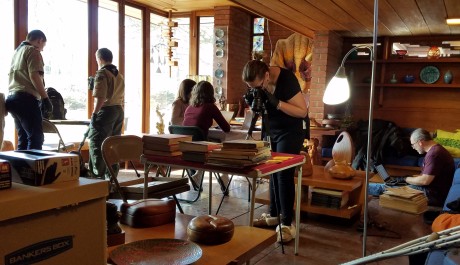This past March, the Center for Collections and Research was honored to host Kevin Wilburn, a Life Scout going for the rank advancement of Eagle Scout, as he performed his required service project.

Eagle Scout badge from scouting.org
The mission of the Boy Scouts of America is to prepare young people to make ethical and moral choices over their lifetimes by instilling in them the values of the Scout Oath and Scout Law. The ranks of the Boy Scouts are Tenderfoot, Second Class, First Class, Star, Life, and Eagle. To receive the highest achievement rank in the Boy Scouts of America, a Life Scout must not only earn twenty-one merit badges but also perform an extensive service project. He must plan, develop, and give leadership to others in a service project helpful to any religious institution, any school, or his community.
Kevin’s project was to work with the book collection in the Frank Lloyd Wright-designed Melvyn Maxwell and Sara Stein Smith House. It was especially great having Kevin work with the house, as Robert Smith, the only son of Melvyn and Sara, also achieved the rank of Eagle Scout in his youth (the Smith House collection contains his Eagle Scout uniform).
When Cranbrook acquired the Smith House late last year, we also acquired the extensive library amassed by the Smiths. The collection of more than 900 works ranges from books on Frank Lloyd Wright to Art in America and other periodicals, to yearbooks and popular fiction.

Kevin and his team working on the Smith House book collection.
On the day of the project, Kevin and his team of scouts and parent volunteers did an inventory of the books in the Living Room and the Study. They utilized a computer program which allowed them to gather all pertinent information about the books by simply searching the Library of Congress Control Number (LCCN) or the International Standard Book Number (ISBN). They also took images of the books as well as any inscriptions found within. What they ended up with, after just one day working in only two rooms in the house, was a database of 658 individual titles. (Knowing how many more books are in the other rooms, maybe there are more than 900 books in the house…)
I recently asked Kevin his thoughts on the project over email:
LM: First off, what does becoming an Eagle Scout mean to you?
KW: I’ve been in Scouts for 11 years now there were times that I questioned my continuation in Scouts. However, on the cusp of this final accomplishment, I don’t regret staying on the path. It has been a lot of commitment and there is no substitution for the hard work required, but as a scout, I have had opportunities so few people get to have—just like doing this project. It is special to be part of the small group of Scouts that accomplish the Eagle Rank. I think the Scout program and achieving Eagle has made me a better person.
LM: Can you give me your overall impression of the Smith House?
KW: To me, I struggle with the words to describe the Smith House. It is truly a one-of-a-kind home and the attention to detail is absolutely marvelous. Whether it’s the striking color of the red tidewater cypress wood that forms the walls or the glistening flat skylights that illuminate the tight, yet airy library, this home is Usonian Style in its truest form. Additionally, there is such a great story to the Smith’s and how the house came to be that makes it even more special than the physical aspects.
LM: What motivated you to take on this project?
KW: The driving force behind this entire project was the fact that I was assisting in the preservation of a Wright-designed home. I’ve always had an appreciation for his work and have a personal interest in helping the preservation of his work. I never expected that I would have such a unique opportunity to combine my passion and interest so directly on my Eagle project—it was a truly special project. I really appreciate the opportunity Cranbrook provided me.

Kevin photographing one of the 658 titles cataloged during the one-day project.
LM: What was the hardest thing about the project?
KW: We had very unique requirements compared to many projects that are often construction based, so going into it I knew that getting people started on the cataloging process would be difficult and it probably took an hour for volunteers to get into a rhythm. It was also physically demanding, in some cases sitting or standing for hours at a time—luckily we were able to rotate some positions to help people with fatigue. In the end, the hardest part was it was a very long 10 hour day typing in book details into our cataloging software and photographing the books.
LM: What was your favorite part of the project?
KW: Planning to pursue architecture as a career, I’ve always been interested in Frank Lloyd Wright; so, my favorite part was to be able to do a project in one of his Usonian homes. It was also exciting during the cataloging process to see some of the personal connections of the Smiths with Wright.
LM: Any final thoughts?
KW: I want to thank Cranbrook Center for Collections and Research, Leslie Mio, Associate Registrar, for supporting the project, and Lynette Mayman, Program Presenter, for being on-site during the project. I also want to thank the members of Troop 1005 that came out to support this effort. Finally, I want to thank Collectorz.com for donating the Book Collector software used to catalog the collection.

Kevin (fourth from the right) and some of his team of volunteers on the back patio of Smith House.
The Center for Collections and Research wishes Kevin the best of luck in achieving his Eagle Rank and would like to thank him and his team for the hours of work on this project.
– Leslie Mio, Associate Registrar










